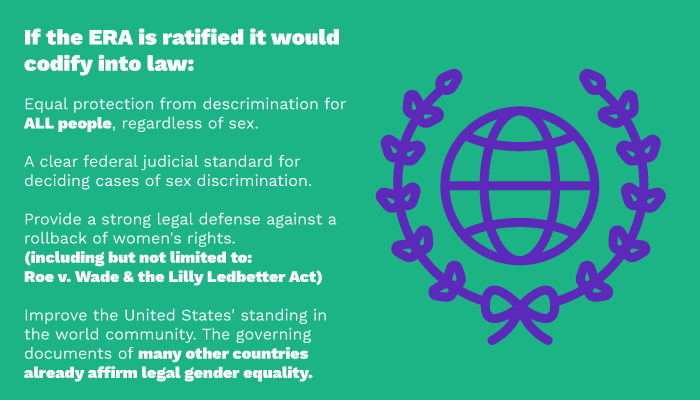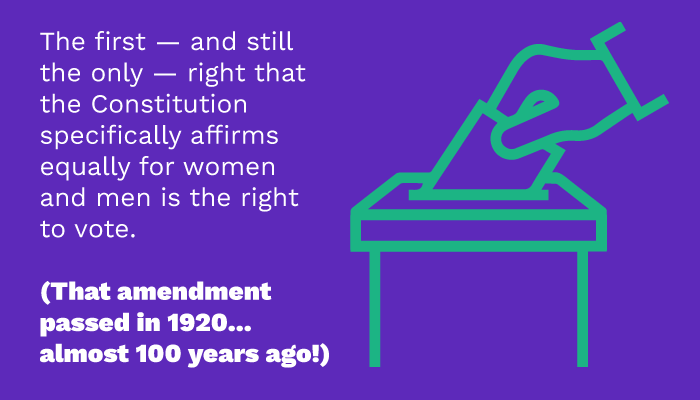Why We Need the Equal Rights Amendment
“Equality of rights under the law shall not be denied or abridged by the United States or by any state on account of sex.” - Section 1, Equal Rights Amendment
After more than a generation of significant advances for women, do we still need the Equal Rights Amendment? Yes, we absolutely do.
Legal sex discrimination is not yet a thing of the past, and the progress of the past 60 years is not irreversible. Remaining gender inequities result more from individual behavior and social practices than from legal discrimination, but all can be positively influenced by a strong message when the U.S. Constitution declares zero tolerance for any form of sex discrimination.
The reasons why we need the ERA are at one level philosophical and symbolic, and at another level very specific and practical.
The first — and still the only — right that the U.S. Constitution specifically affirms equally for women and men is the right to vote.
Equal rights activist Alice Paul first introduced the ERA in 1923 to expand the rights guaranteed by the U.S. Constitution to both genders. She understood the importance of constitutional protections for all citizens when she argued, "We shall not be safe until the principle of equal rights is written into the framework of our government."
Without the ERA, the U.S. Constitution does not explicitly guarantee that the rights it protects are held equally by all citizens without regard to sex. The first — and still the only — right that the U.S. Constitution specifically affirms and applies equally to women and men is the right to vote.
The equal protection clause of the U.S. Constitution's 14th Amendment was first applied to sex discrimination only in 1971, and it has never been interpreted to grant equal rights on the basis of sex in the uniform and inclusive way that the ERA would.
The ERA would provide a clearer judicial standard for deciding cases of sex discrimination. Not every state in the U.S. has ratified the Equal Rights Amendment, and therefore federal and state courts are inconsistent in their rulings regarding claims of sexual discrimination claims. The ERA would help clarify sex discrimination jurisprudence and conclusively invalidate the claim of late Supreme Court Justice Antonin Scalia that the Constitution, specifically the 14th Amendment, does not protect against sex discrimination (reported in California Lawyer, January 2011).
The ERA would provide a strong legal defense against a rollback of the significant advances in women's rights that have been achieved since the mid–20th century.
Without the ERA women regularly — and occasionally men — have to fight long, expensive, and difficult legal battles in an effort to prove that their rights are equal to those of the other sex.
The ERA would improve the United States' standing in the world community with respect to human rights. The governing documents of many other countries affirm legal gender equality, however imperfect the global implementation of that ideal may be.
The Equal Rights Amendment is needed to constitutionally affirm that the bedrock principles of our democracy — "all men are created equal," "liberty and justice for all," "equal justice under law," "government of the people, by the people, and for the people" — apply equally to women and men in the United States of America.
It is necessary to have specific language in the U.S. Constitution affirming the principle of equal rights on the basis of sex because for more than two centuries, women have had to fight long and hard political battles to win rights that men (initially certain white men, and eventually all men) possessed automatically because they were born male.
It was not until as recently as 1971 that the 14th Amendment's equal protection clause was first applied to sex discrimination. Even today, a major distinction between the sexes is present from the moment of birth — the different legal standing of males and females with respect to how their constitutional rights are obtained. As demonstrated in 1996 by the last major Supreme Court decision on sex discrimination, which dealt with admission of women to Virginia Military Institute (VMI), we have not moved beyond the traditional assumption that males hold rights and females, if treated unequally, must prove that they hold them.
The Equal Rights Amendment would remove that differential assumption.
The practical effect of this amendment would be seen most clearly in court deliberations on cases of sex discrimination. For the first time, "sex" would be a suspect classification requiring the same high level of "strict scrutiny" and having to meet the same high level of justification — a "necessary" relation to a "compelling" state interest — that the classification of race currently requires.
The VMI decision now tells courts to exercise "skeptical scrutiny" requiring "exceedingly persuasive" justification of differential treatment on the basis of sex, but prohibition of sex discrimination is still not as strongly enforceable as prohibition of race discrimination. Ironically, under current court decisions about sex and race discrimination, a white male claiming race discrimination by a program or action is protected by strict scrutiny, but a black female claiming sex discrimination by the same program or action is protected by only skeptical, not strict, scrutiny.
We need the Equal Rights Amendment to clarify the law for the lower courts, whose decisions still reflect confusion and inconsistency about how to courts deal with sex discrimination claims. If the ERA were in the U.S. Constitution, it would - in many cases - influence the tone of legal reasoning and decisions regarding women's equal rights, producing a cumulative positive effect over time as discrimination cases are brought forth.
The Equal Rights Amendment is needed in order to prevent a rollback of women's rights by conservative or reactionary political votes. The ERA will promote laws and court decisions that fairly take into account women's, as well as men's, experiences.
Some ask: Aren't there already enough legal prohibitions of sex discrimination?” Aren’t women protected from discrimination by laws such as:
Equal Pay Act (1963)
Title VII and Title IX of the Civil Rights Act (1964)
Pregnancy Discrimination Act (1978)
Supreme Court decisions based on the 14th Amendment's equal protection clause
While these laws do protect women from gender-based discrimination, court rulings over the years since their passage have created legal precedent regarding how the laws can be interpreted and enforced, often to the detriment of what the laws were originally intended to protect women from. Without the ERA, gender-based discrimination is becoming harder and harder to prove in a court of law. Until the U.S. Constitution is amended to explicitly state that equality of rights cannot be denied or abridged on account of sex, the political and judicial victories women have achieved with over two centuries are vulnerable to erosion or reversal at any time — now or in the future.
Congress has the power to make laws that replace existing laws — and to do so by a simple majority. Therefore, many of the current legal protections against sex discrimination can be removed by the margin of a single vote. While courts in the near term would still apply skeptical scrutiny to laws that differentiate on the basis of sex, that precedent could be undermined or eventually ignored by future conservative or reactionary courts.
With a specific constitutional guarantee of equal rights through the Equal Rights Amendment, it would be much harder for legislators and courts to reverse our progress in eliminating sex discrimination.
Would anyone really want to turn back the clock on women's advancement? YES. Many people do.
Examine the members of Congress who have:
tried to cripple Title IX, which requires equal opportunity in education
opposed the Violence Against Women Act, the Fair Pensions Act, and the Paycheck Fairness Act
voted to pay for Viagra for servicemen but oppose funding for family planning and contraception
for decades blocked U.S. ratification of the United Nations Convention on the Elimination of All Forms of Discrimination Against Women (CEDAW)
Most laws that discriminated explicitly against women have been removed from the books — in many cases, as a result of the political power and expertise developed by women in the course of the ERA ratification campaign.
The current legal and judicial systems, however, still often have an impact on women that works to their disadvantage, because those systems have traditionally used the male experience as the norm. Therefore, lawmakers and judges must be encouraged to include equitable consideration of female experiences as they deal with issues of Social Security, taxes, wages, pensions, domestic relations, insurance, violence, and more. Without an Equal Rights Amendment providing motivation, the status quo will change much more slowly.
Ready to help ratify the ERA?
The greatest thing you can do to help ensure the Equal Rights Amendment is ratified is to share information about the ERA with your friends and family. Dive deeper into this website to explore the history of the ERA and to see if your state has ratified it.
To help you become an ERA Advocate, we have created a fabulous ERA Toolkit! It is full of a wide variety of ready-to-post social media items, white papers, presentations, and ready-to-print files for posters, buttons, stickers, and postcards — all made available for FREE.





